Discus Fish: Everything You Need To Know!
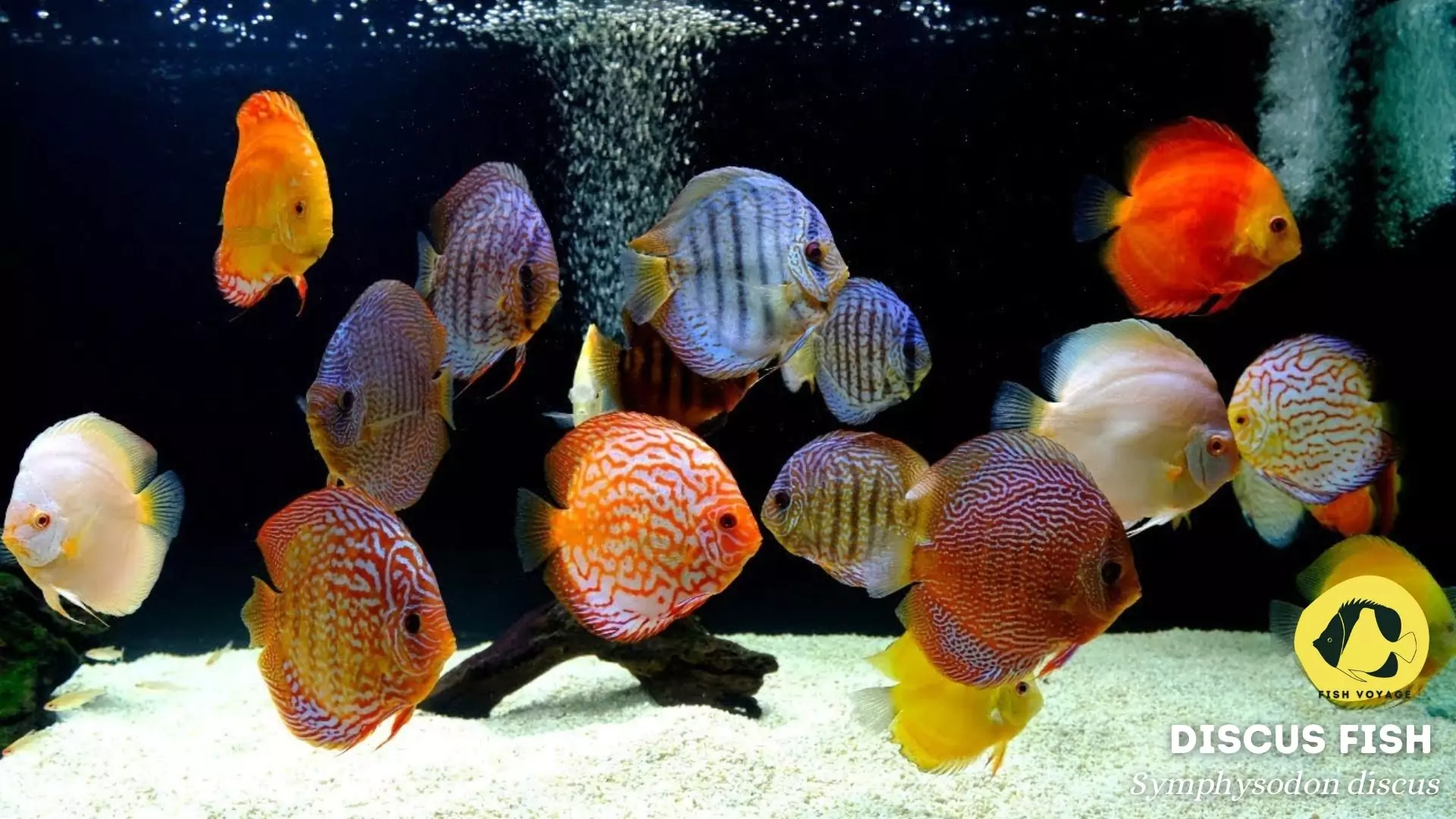
Discus fish, with their vibrant colors and graceful movements, have long captivated the hearts of aquarium enthusiasts worldwide. These majestic creatures, often hailed as the “kings of the aquarium”, possess an unmatched elegance that transforms any tank into a mesmerizing aquatic masterpiece. In this comprehensive guide, we delve into the fascinating world of discus fish, exploring their rich history, unique physical characteristics, and the intricacies of their care and maintenance. Whether you’re a seasoned hobbyist or a newcomer to the world of aquarium keeping, join us as we embark on a journey to discover everything you need to know about these enchanting aquatic gems.
History of Discus Fish
Origins
- Discus fish, scientifically known as Symphysodon, are native to the Amazon River basin in South America, particularly in the slow-moving, heavily vegetated waters of the Amazon tributaries.
- These captivating fish were first discovered in the mid-19th century by explorers fascinated by the biodiversity of the Amazon rainforest. Their striking appearance and unique behaviors quickly garnered attention among aquarists worldwide.
Evolution in the Aquarium Trade
- Initially, discus fish were rare and challenging to obtain due to the difficulties in capturing and transporting them from their natural habitat.
- However, advancements in aquarium technology and breeding techniques revolutionized the availability of discus fish in the aquarium trade.
- Breeders worldwide began selectively breeding discus fish for desirable traits such as vibrant colors, symmetrical patterns, and robust health, leading to the development of various discus fish strains and varieties.
Cultural Significance
- Discus fish hold significant cultural importance, particularly among indigenous tribes living along the Amazon River.
- In some indigenous cultures, discus fish are revered as symbols of fertility, prosperity, and harmony with nature.
- Additionally, discus fish have gained popularity in the arts, literature, and folklore of the regions where they are found, further cementing their cultural significance.
Physical Characteristics
Description of Physical Characteristics
- Discus fish are renowned for their unique disc-shaped bodies, which are laterally compressed and slightly oval in shape.
- They exhibit a kaleidoscope of vibrant colors, ranging from brilliant shades of red, blue, green, and yellow to more subdued hues like brown and black.
- One of the most captivating features of discus fish is their intricate patterns, which can include stripes, spots, and even marbling effects. These patterns often vary significantly between individual fish, adding to their allure.
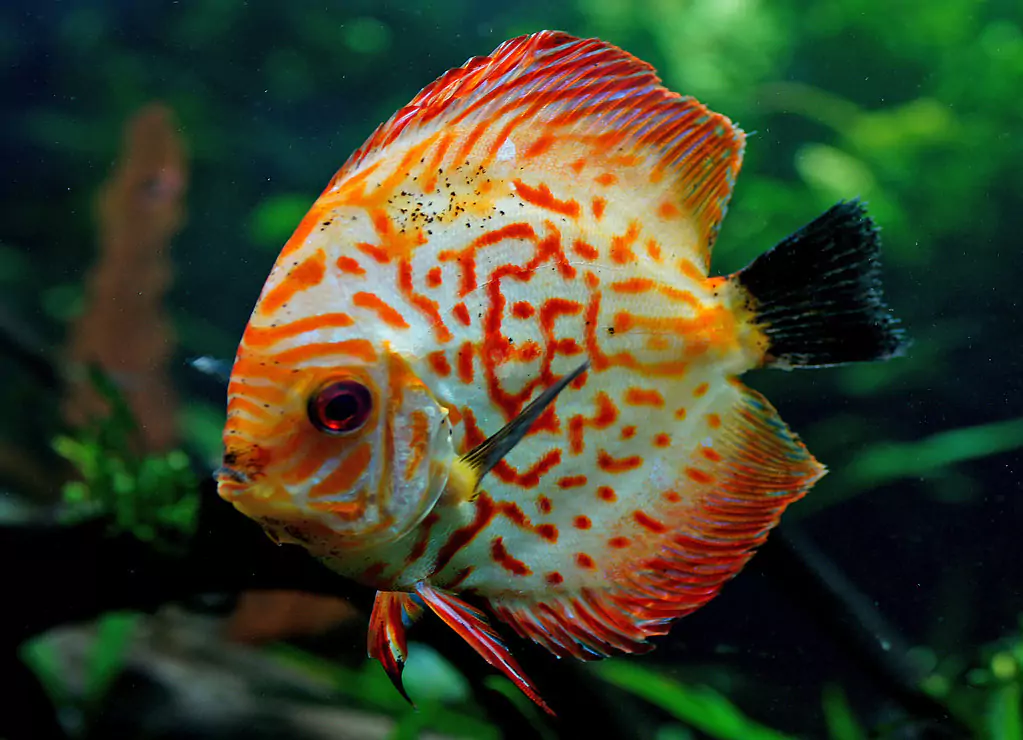
Varieties
- Over the years, breeders have developed numerous varieties of discus fish, each with its own distinct characteristics.
- Some popular varieties include the Pigeon Blood, Marlboro Red, Blue Diamond, and Turquoise discus, each named for its dominant coloration and pattern.
- Additionally, there are wild-type discus, which closely resemble their counterparts in the Amazon basin, and more selectively bred strains known for their intense colors and unique markings.
Size and Growth
- Discus fish are relatively slow-growing compared to other aquarium fish species, typically reaching a size of around 6 to 7 inches in diameter in optimal conditions.
- Juvenile discus fish may start out small, but they undergo rapid growth during their first year of life, provided they receive proper nutrition and care.
- It’s essential to provide adequate space and a balanced diet to support healthy growth and development in discus fish, as overcrowding and poor water quality can stunt their growth.
Habitat and Tank Requirements
Ideal Tank Setup
- Tank Size: Discus fish thrive in spacious aquariums with a minimum size of 50 gallons for a small group of fish. Larger tanks of 75 gallons or more are recommended for a community of discus.
- Filtration: A high-quality filtration system, such as a canister filter, is essential to maintain optimal water quality and remove waste. A combination of mechanical, biological, and chemical filtration ensures a healthy aquatic environment for discus fish.
- Water Parameters: Discus fish are sensitive to water conditions, requiring stable parameters for optimal health. Ideal water temperature ranges from 82°F to 86°F, with a pH level between 6.0 and 7.0. Soft, slightly acidic water mimicking their natural habitat is preferred.
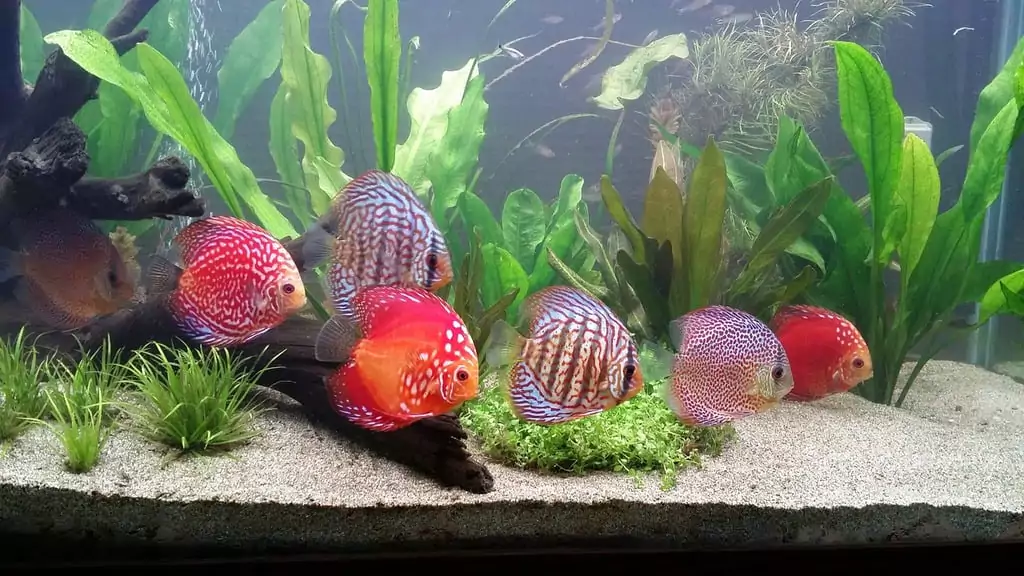
Importance of a Well-Established Tank Ecosystem
- Establishing a well-balanced ecosystem in the aquarium is crucial for the long-term health and well-being of discus fish.
- Cycling the tank before introducing discus fish helps establish beneficial bacteria that break down waste and maintain water quality.
- Live plants, driftwood, and rocks not only enhance the aesthetic appeal of the tank but also provide hiding places and natural foraging areas for discus fish.
Tank Mates
- Discus fish are peaceful by nature and should be kept with compatible species that share similar water parameters and temperament.
- Suitable tank mates for discus fish include peaceful community fish such as tetras, dwarf cichlids, and peaceful bottom-dwelling species like Corydoras catfish.
- Avoid aggressive or fin-nipping species that may stress or harass discus fish, as they are sensitive to disturbances and can become prone to health issues in such environments.
Feeding and Nutrition
Dietary Needs
- Discus fish are omnivorous and require a varied diet to thrive. Their natural diet in the wild consists of small invertebrates, insects, and plant matter.
- In captivity, it’s essential to replicate their natural diet by offering a combination of high-quality commercial foods such as pellets, flakes, and freeze-dried or frozen foods like bloodworms, brine shrimp, and daphnia.
- Additionally, providing occasional treats such as blanched vegetables or live foods like blackworms can help meet their nutritional needs and encourage natural feeding behaviors.
Feeding Schedule and Frequency
- Discus fish should be fed small, frequent meals throughout the day to mimic their natural feeding behavior.
- A feeding schedule of 2-3 times daily is recommended, offering only what the fish can consume in a few minutes to prevent overfeeding and maintain water quality.
- Pay attention to the fish’s behavior and adjust the feeding schedule as needed, as individual fish may have different appetites and preferences.
Tips for Ensuring Optimal Nutrition and Health
- Rotate between different types of food to provide a balanced diet and prevent nutritional deficiencies.
- Avoid overfeeding, as excess food can lead to water quality issues and digestive problems. Remove any uneaten food promptly after feeding.
- Supplement their diet with vitamin-enriched foods or dietary supplements if needed, especially for breeding or growing discus fish.
- Monitor their condition closely and adjust feeding amounts based on their growth rate, activity level, and overall health.
Health and Maintenance
Common Health Issues
- Discus fish are susceptible to various health issues, including bacterial, fungal, and parasitic infections, as well as nutritional deficiencies.
- Key signs of health problems in discus fish include loss of appetite, abnormal swimming behavior, changes in coloration, and visible lesions or sores.
- Prevention is key to maintaining the health of discus fish. Ensure optimal water quality, provide a balanced diet, and quarantine new fish to prevent the spread of diseases.
Regular Maintenance Routines
- Regular water changes are essential for maintaining pristine water quality and preventing the buildup of toxins and waste products. Aim for weekly water changes of 25-50% to remove accumulated pollutants.
- Routine tank maintenance tasks such as gravel vacuuming, filter cleaning, and algae removal should be performed regularly to keep the aquarium environment clean and healthy for discus fish.
- Monitor water parameters such as temperature, pH, ammonia, nitrite, and nitrate levels regularly using a reliable test kit and take corrective action if parameters deviate from optimal ranges.
Signs of a Healthy Discus Fish
- A healthy discus fish should exhibit vibrant coloration, clear eyes, and a sleek, streamlined body.
- They should be active and alert, swimming gracefully throughout the tank and interacting with their environment.
- Healthy discus fish will have a hearty appetite and eagerly accept food during feeding times.
- Observing their behavior and appearance regularly allows you to detect any signs of illness early and take prompt action to address any health issues.
Breeding Discus Fish
Conditions for Successful Breeding
- Water Parameters: Maintaining stable water parameters is crucial for successful breeding. Discus fish prefer soft, slightly acidic water with a pH between 6.0 and 6.5 and a temperature of 82°F to 86°F.
- Diet: Providing a nutritious diet rich in protein and essential nutrients is essential for breeding discus fish. High-quality live and frozen foods such as bloodworms, brine shrimp, and daphnia can stimulate breeding behavior.
- Tank Setup: A dedicated breeding tank with ample hiding places such as caves, plants, and flat surfaces for egg attachment is necessary. Use a sponge filter to provide gentle filtration and avoid sucking up fry.
Spawning Behavior
- Discus fish are known for their intricate courtship rituals, which often involve pairs swimming together in tight circles, lip-locking, and displaying vibrant colors.
- During spawning, the female lays eggs on a flat surface, such as a leaf or a piece of slate, while the male fertilizes them. Both parents then take turns guarding the eggs and fanning them to provide oxygen until they hatch.
Rearing Fry
- After the eggs hatch, the fry are initially free-swimming and may feed off their yolk sacs for the first few days. Offer newly hatched brine shrimp or specialized fry food to supplement their diet.
- Maintain pristine water quality and perform regular water changes to prevent the buildup of waste and ensure optimal conditions for the fry’s growth and development.
- As the fry grow, gradually introduce finely crushed flakes and powdered foods to their diet. Monitor their growth closely and separate large fry from smaller ones to prevent cannibalism.
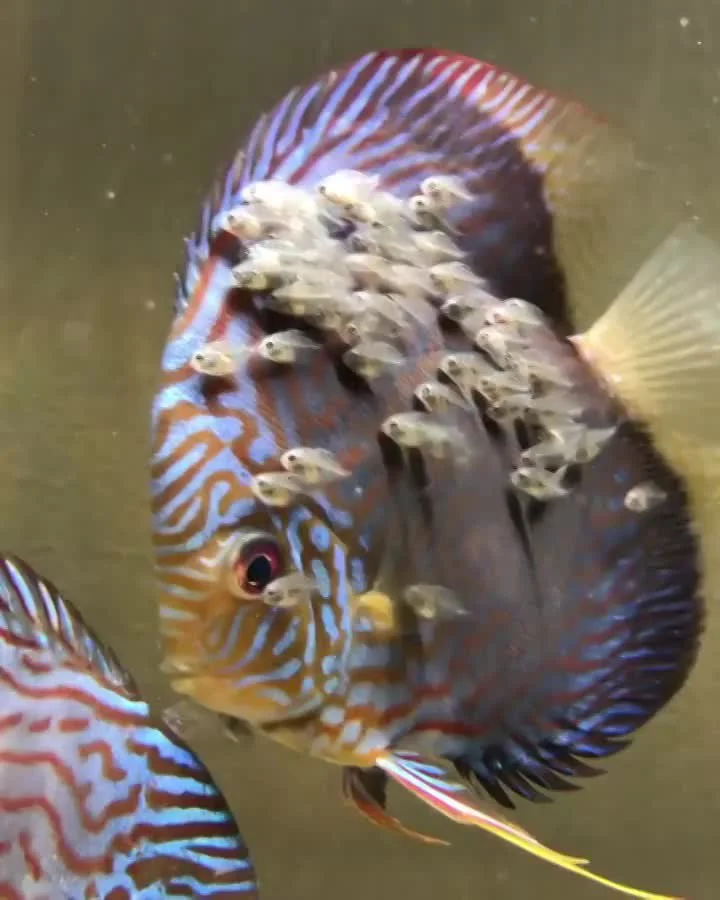
Tips for Choosing and Purchasing
Selecting Healthy Specimens
- Body Shape and Size: Look for discus fish with a symmetrical and streamlined body shape, free from deformities or abnormalities. Avoid fish that appear emaciated or overly thin.
- Vibrant Coloration: Healthy discus fish exhibit bright and consistent coloration across their entire body. Avoid specimens with faded or dull colors, as this may indicate stress or illness.
- Behavior: Observe the fish’s behavior closely. Healthy discus fish should be active and alert, swimming gracefully and interacting with their surroundings. Avoid fish that appear lethargic or listless.
- Cleanliness: Check the tank or aquarium where the discus fish are housed. It should be clean and well-maintained, with clear water and no signs of disease or parasites among the fish.
Quarantine Procedures
- Quarantine Tank: Before introducing new discus fish into your main aquarium, quarantine them in a separate tank for a period of 2-4 weeks. This allows you to monitor their health and behavior closely and prevents the spread of diseases to your existing fish.
- Observation Period: During the quarantine period, observe the new fish for any signs of illness or abnormalities. Treat them as needed for parasites or infections before transferring them to the main aquarium.
- Water Parameter Adjustment: Gradually acclimate the quarantined discus fish to the water parameters of your main aquarium by slowly adjusting the temperature and pH over a period of several days to minimize stress.
Conclusion
In conclusion, we’ve explored the fascinating world of discus fish, covering everything from their captivating physical characteristics to the intricacies of their care and breeding. By understanding the ideal habitat, feeding requirements, and maintenance routines, you can provide a nurturing environment for these majestic creatures. As you embark on the rewarding journey of keeping discus fish, remember that patience and dedication are key to success. Whether you’re a seasoned hobbyist or a newcomer to the hobby, we encourage you to dive into the world of discus fishkeeping and experience the joy of nurturing these beautiful aquatic gems. We invite you to share your own experiences, tips, and questions in the comments below, as we continue to foster a community of passionate aquarium enthusiasts.
Additional Resources
Authoritative Books
- The Discus: An Owner’s Guide to a Happy Healthy Fish by Mic Hargrove: This comprehensive guide covers all aspects of discus fish care, from tank setup and maintenance to breeding and health management.
- Discus Fish Complete Pet Owner’s Manual by Thomas A. Giovanetti: Written by an experienced aquarist, this manual provides practical advice and insights into keeping discus fish thriving in the home aquarium.
Recommended Products
- Aquarium Test Kit: Ensure optimal water quality with a reliable aquarium test kit such as the API Freshwater Master Test Kit, which allows you to monitor key parameters like pH, ammonia, nitrite, and nitrate.
- Quality Fish Food: Provide a balanced diet for your discus fish with high-quality fish foods like Hikari Bio-Pure Freeze Dried Bloodworms or TetraColor Tropical Flakes.
- Heater and Thermometer: Maintain stable water temperature within the recommended range for discus fish with a reliable aquarium heater and thermometer, such as the Eheim Jager Aquarium Thermostat Heater.
Frequently Asked Questions (FAQs)
1. What size tank do discus fish need?
Discus fish thrive in spacious aquariums with a minimum size of 50 gallons for a small group of fish. Larger tanks of 75 gallons or more are recommended for a community of discus. Providing ample space allows for better water quality and reduces stress on the fish.
2. What do discus fish eat?
Discus fish are omnivorous and require a varied diet to thrive. Their diet should include high-quality commercial foods such as pellets, flakes, and freeze-dried or frozen foods like bloodworms, brine shrimp, and daphnia. Offering occasional treats such as blanched vegetables or live foods can also supplement their nutritional needs.
3. Are discus fish difficult to care for?
While discus fish have specific care requirements, they can be kept successfully with proper attention to their needs. Maintaining stable water parameters, providing a balanced diet, and regular tank maintenance are essential for keeping discus fish healthy. With dedication and commitment, discus fish can thrive in the home aquarium.
4. Can discus fish be kept with other fish species?
Discus fish are peaceful by nature and can coexist with compatible tank mates that share similar water parameters and temperament. Suitable tank mates include peaceful community fish such as tetras, dwarf cichlids, and peaceful bottom-dwelling species like Corydoras catfish. Avoid aggressive or fin-nipping species that may stress or harass discus fish.
5. How do I know if my discus fish are healthy?
Healthy discus fish exhibit vibrant coloration, clear eyes, and a sleek, streamlined body. They should be active and alert, swimming gracefully throughout the tank and interacting with their environment. Regular monitoring of their behavior and appearance allows you to detect any signs of illness early and take prompt action to address any health issues.


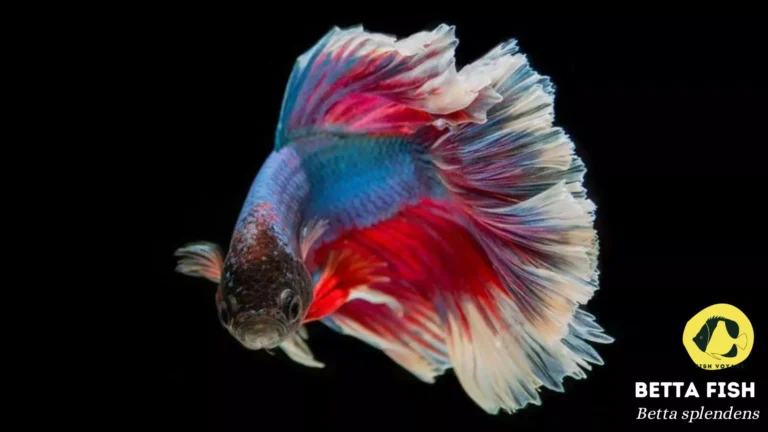

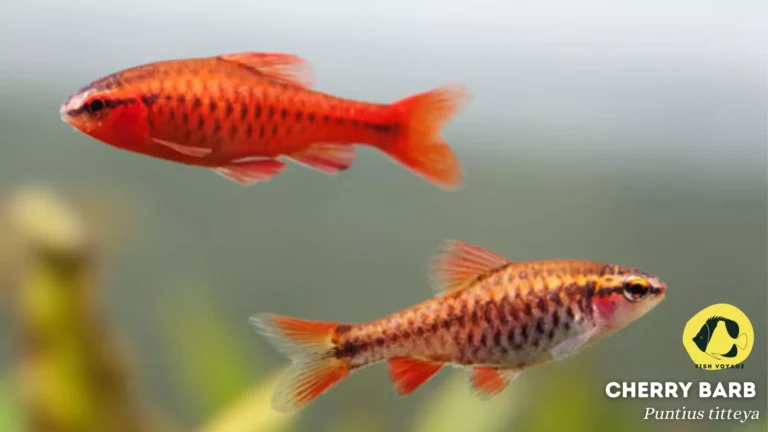
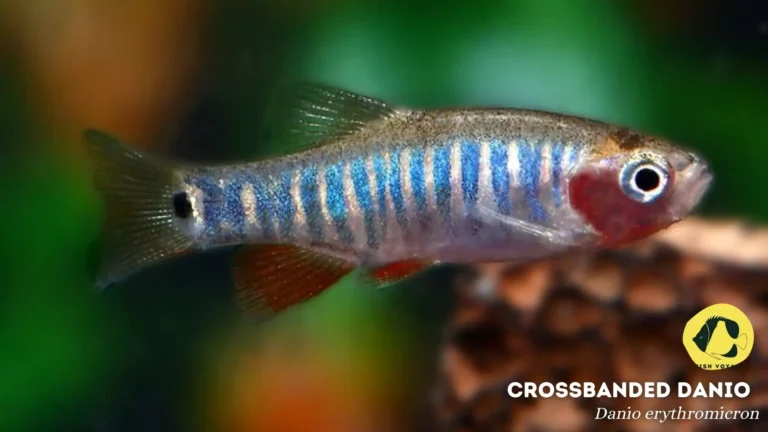
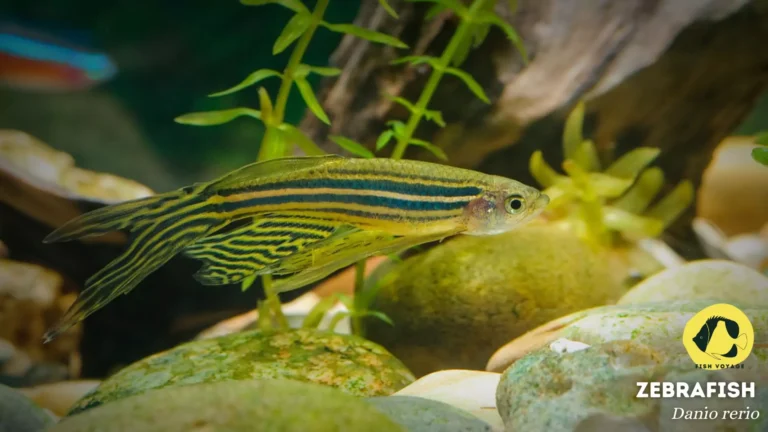
I have learn some excellent stuff here. Definitely value bookmarking for revisiting. I wonder how much effort you put to create any such fantastic informative website.
Thank you so much for your kind words! We’re thrilled to hear you find the content appealing. Stay tuned for more interesting posts!